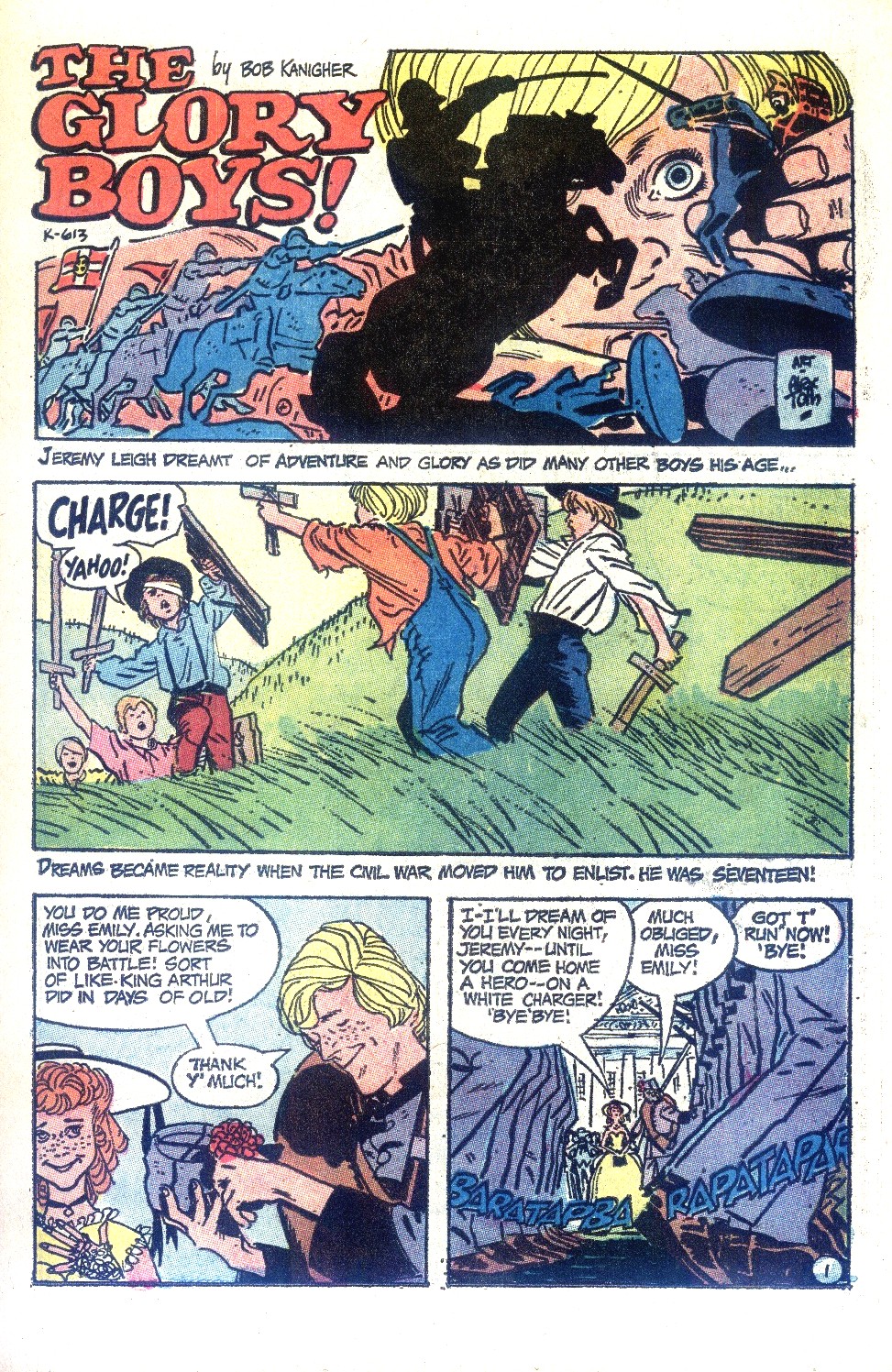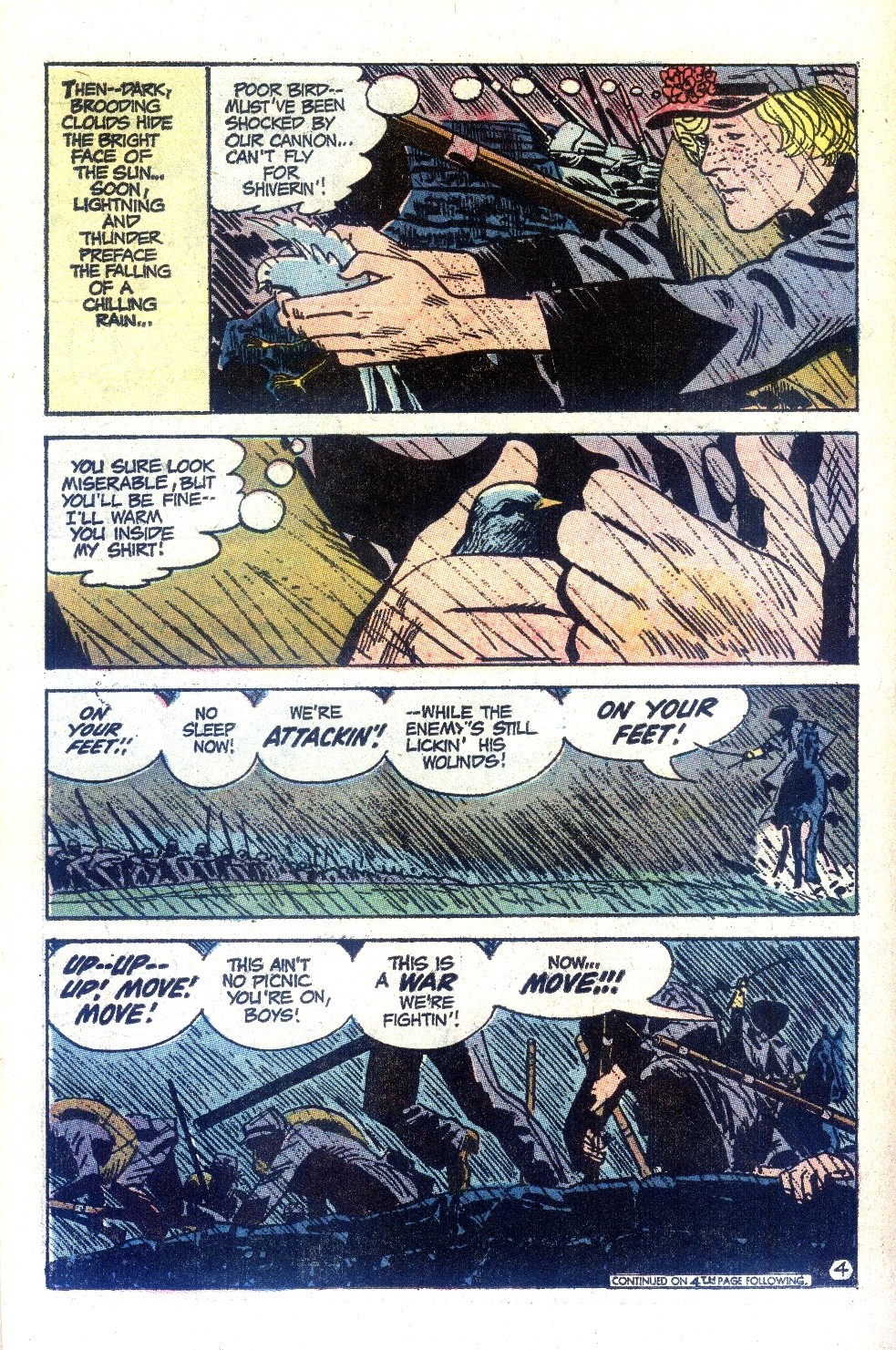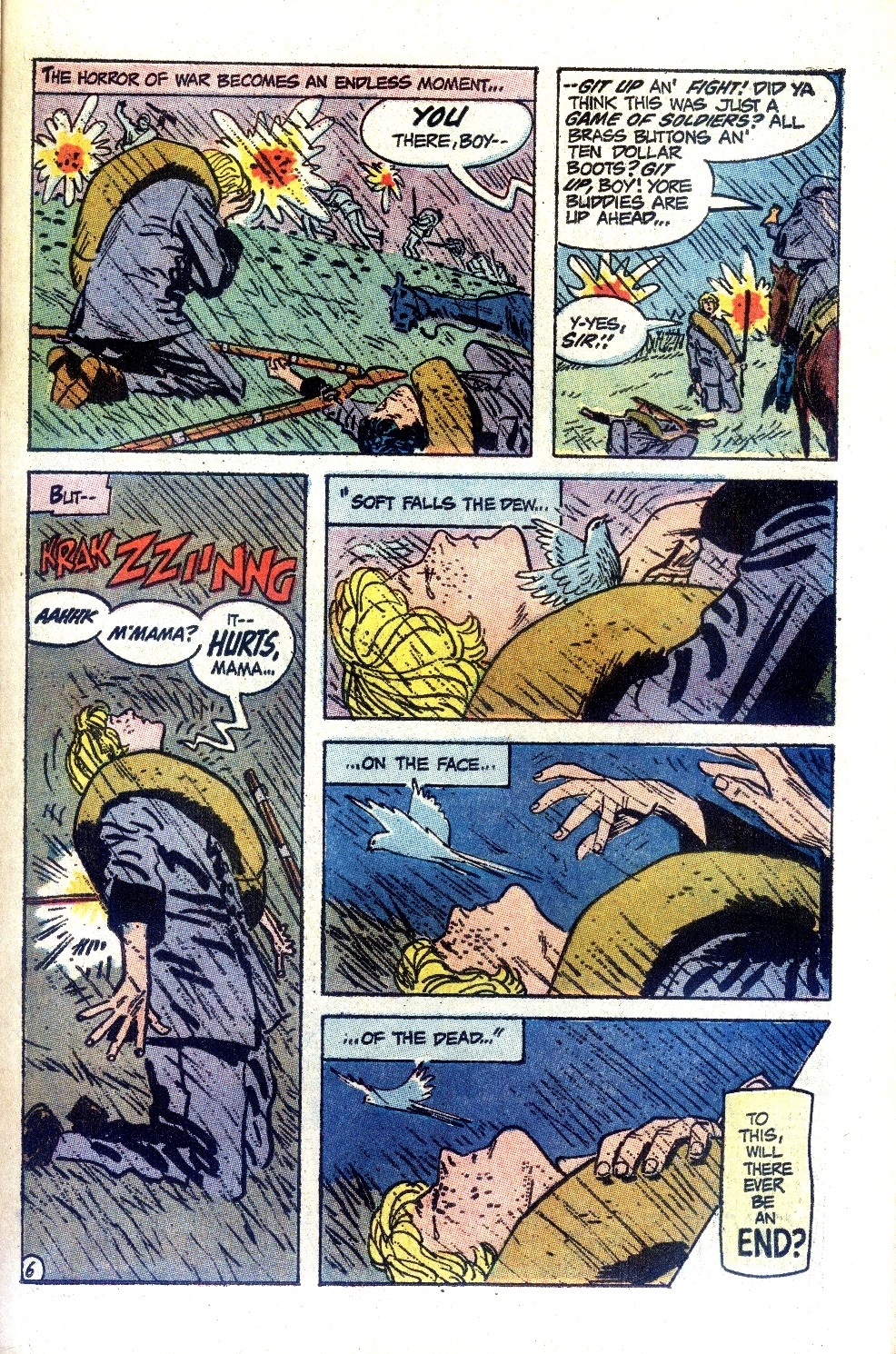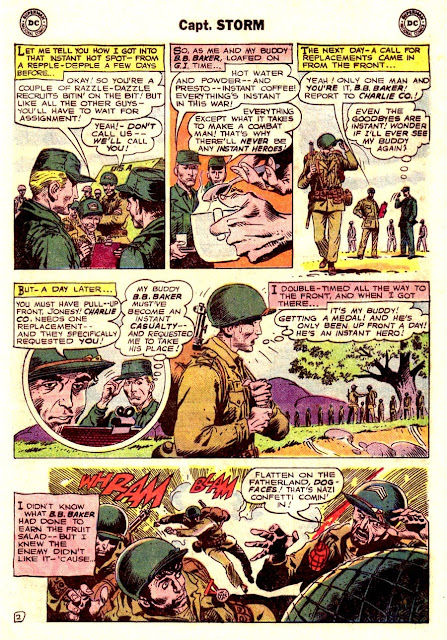Our Army at War #235

A few good stories in this one! Joe Kubert was the editor of the war books, at this point and they are using the "Make War No More" tag at the end of their stories. That didn't stop them from reprinting old gung ho stories or new ones; but the focus did tend to be more on the human side of things.
The opening story is from Robert Kanigher and Russ Heath, featuring Sgt. Rock in "Pressure Point." The opening sees Rock and Easy in the middle of a heavy firefight, as Easy is trying to storm a German machine gun position. Bulldozer goes down, Wild Man goes down, Little Sure Shot is hit, Jackie Johnson and Ice Cream Soldier are all hit and appear to be dead. Rock wakes up screaming and thrashing, in an Army mobile hospital, while orderlies try to restrain him. The doc tells him the war has been too much and Rock has met his pressure point and he is sending him home. However, Rock finds out his men are alive, just wounded. The joy is short lived as a German plane strafes the hospital. Rock sends Bulldozer to recon and he discovers the Germans are entering the area in force, as he spots some GIs battling a King Tiger tank.

They concentrate their fire on the tank's viewports and succeed in igniting the gasoline fuel inside, destroying the tank. Dozer reports back and Rock assembles the walking wounded to mount a defense. They take a position around the destroyed tank and meet the German advance, fighting hard. The battle is going against Easy when the GIs that assaulted the tank with Bulldozer, return with reinforcements. Afterward, Rock and Easy head back to the line, in defiance of the doctor who wanted to ship Rock home.
Russ Heath's art is tremendous and I wish I could find scans of this story. There is a two-page title spread, with Rock being restrained in the hospital, as he has visions of his "dead" men. Heath is at the top of his game. Anyone who said that the DC books looked boring, compared to Marvel, at that time, did not look at the war comics. Heath is as dynamic as anyone, capturing the emotional turmoil, determination, and joy at various stages. The story itself is a bit hyperbolic, as Rock's frenzy is a bit over-the-top and the idea of a doctor in a field hospital sending a non-com home on the basis of what we see is laughable. At best, he would have been sent to the rear for further observation, before a determination of shipping him home. More than likely, he would have been sent to a fully-fledged hospital and some RnR, before going back to the line.
This was the point where Jackie Johnson was a regular, ignoring the segregation of the US Army, following Marvel with Sgt Fury and Gabe Jones. Racism is a topic in at least one Rock story, "A Penny for Jackie Johnson, " (OAAW #179) and one where he meets an old German boxing opponent, "What's the Color of Your Blood" (I will cover those stories, later). As did Marvel, DC went the easy route of showcasing racism, without taking on the institutional racism of the US Army, in WW2. By the time of this story, the Army had been integrated for over 20 years, however, there were racial issues within the military during and after the Vietnam War. DC wasn't quite prepared to take on the US Army and railing against the government wasn't DC's style. Instead, it was far easier to do a dramatic depiction of racism and show that the minority character is the same as everyone else.
The German plane attack is a bit much, as the Germans didn't generay deliberately target hospitals, though confusion has caught them in a crossfire. The story has the plane bearing down on the tent, with the big red cross on the roof. This is more than a bit jingoistic and a bit insulting to the Luftwaffe pilots. The Germans committed many atrocities; but, as a general rule, the Luftwaffe and the Wehrmacht abided by the Geneva Convention, when dealing with the Allied armies. The Russians were another story, though. The Germans were far less concerned in their dealings with them.
The next story is a USS Stevens tale, from Sam Glanzman: "Kamikaze."

The story is set near the end of the war, as an American fleet is massed at Okinawa, waiting for the invasion of the Japanese home islands. By this point, Okinawa was a staging ground for that planned operation, while B-29 strikes were ravaging Japan, as well as carrying out Operation Starvation, in which mines were air-dropped by B-29s, cutting off Japan's harbors, preventing troop movements, fishing, and other shipping. The Japanese sent
Kamikaze attacks on the US fleet, using old planes, the
Oku rocket plane, and even wooden gliders.
Our story sees a squadron of
kamikaze planes headed for the fleet. One plane is piloted by Tatsuno Sakigawa. He believes in his mission to defend his homeland with his life, in the
bushido tradition of the
samurai. As he nears the fleet, he thinks back upon his life, of his mother and family, the
kabuki plays, the temples,
sumo matches, the fishing village from which he came. Reality awakens him as shells burst around him. He steers through, heading for his target. He thinks back to his parents...

We learn that they were killed in the US firebombing of Tokyo, in March, 1945. The USAAF dropped 16500 tons of incendiary bombs on Tokyo and the firestorm caused over 100,000 casualties and destroyed nearly 16 square miles of the city. Other Japanese cities were targeted and devastated.
Tatsuno puts his plane in a dive and slams into a US warship, in a fiery blast. The story ends with a note that 250, 000 Japanese died in firebombing raids, vs 80, 000 at Hiroshima. Figures vary, depending on the source and I have seen one of about 241, 000 casualties due to bombing, though I can't determine if that statistic is just for firebombing missions or also includes the bombings of Hiroshima and Nagasaki. Regardless of the actual number, Glanzman is correct (or Joe Kubert, if editorial inserted that note) that the Japanese suffered more casualties from firebombing campaigns than the atomic bombs. These raids were just as controversial, as they largely targeted the civilian populace, though raids were conducted on air bases that were used to stage
kamikaze attacks on the US fleet, off Okinawa.
Glanzman's story gives us the point of view of the Japanese enemy. We see him not as an abstract fanatic, shouting
banzai and rushing to his death. He is a young man who came from a loving family and who enjoyed the art and sport of his culture. He was swept up in a war and suffered personal loss at the hands of his country's enemy. He goes to land a blow for his family and his country, just as much as any soldier on the Allied side. The difference is our sympathies are on the Allied side, as that is our culture. Like Enemy Ace, this story gives us a window into the human side of our previous enemy. This was a rare thing in war comics; but, because of stories like this and Enemy Ace, it became a more common thing.
The greatness of this issue continues, as the next story is a Civil War tale, "The Glory Boys," with Alex Toth. This is considered to be one of Toth's greatest pieces in the war comics, along with the tale, "Burma Sky."

Our story opens with a young Southern boy, Jeremy Leigh. Jeremy and his friends play "war" and play with tin soldiers, like many boys of their age. Time passes and the older Jeremy is now part of the Confederate Army, heading off to his first battle. He is sent off to become a hero by his girl, Emily, who dreams of him returning on a white charger. The men march off to drums and believe they are bound for glory. They reach their position and rest and the young men enjoy the scenery and joke. An officer comes riding through calling the men to prepare for an attack. They see the Bluecoats in the distance and take aim with their rifles. Jeremy kills a soldier from long range and thinks he went down like a tin soldier. He kills more before the attack ends. Rain comes in and Jeremy finds a bird that has been shocked by the battle and rain and puts it in his coat to keep it warm. Another officer rides along and tells them men that they are attacking, while the enemy licks his wounds.

This time is different. The Bluecoats fire back and shells hit around them, killing the officer and gravely wounding his horse. Jeremy's friend Enoch says they need to put the horse out of his misery, but Jeremy can't bring himself to do it. he freezes up as Enoch is shot and goes down. He falls to his knees...

Jeremy is like so many young boys who play at war, only to find themselves thrust into it later and learn that war is no game; just killing and dying. This story fits the the theme of Joe Kubert's war books, "Make War No More!" Gone are the heroics, the battle off the virtuous GI and the evil enemy. This is a young man who had his life ahead of him, who had loved ones left behind, who marched off to find glory and found only a painful death. Robert Kanigher wrote this and it brims a bit with stereotype; but, Alex Toth's minimalist art really sells home the point. He captures the innocence of the boys at the beginning, the starry-eyed dreams as the men march off, the quiet before the battle, the initial fight that still seems a game, and the stark terror and pain as reality hits home. Quite frankly, the art carries the story far better than the words and a silent piece would be just as effective, thanks to Toth's choice of the perfect images. Toth strove to use only the necessary lines, the necessary panels to convey the story and he succeeded magnificently here.
After two classics and one artistically great story, we still get more. Russ Heath has another story, "Wall For a Fighting Man" (no writer is credited). We see a pilot, who has been shot down and has taken refuge behind a pile of rubble, in a stark landscape. A tank is closing in and we learn that the rubble was once part of the wall of a Roman fortress. We see how a Roman sentry fights off an enemy attack from that position, dying in the process. That position is treated with honor by the Romans. Later, in the Middle Ages, it is part of a fortification, as an archer takes refuge from attacking knights. Still later, it holds a machine gun position which fights off a German attack. Back in the present, our pilot makes a desperate action and fires a flare pistol into the view slit of the tank, igniting the gasoline inside. He lives and thanks the wall for sheltering him as he walks off. Above him, we see clouds form the faces of the Roman, the medieval archer, and the doughboys.
This is a more typical tale of the war comics of the era. Not quite a classic; but, a decent average story of warfare through the ages. The setting is rather nebulous and appears to be North Africa, at first; but, the WW1 sequence would suggest it was Europe, as the desert fighting of WW1 was pretty much the province of the British and Colonial armies, at places like Gallipoli and Bersheba, as well as Lawrence's Arab Army.
Our last story is a reprint from Captain Storm #6, "Instant Soldier," with art by Joe Kubert. This is from Kanigher's editorship and the writer is Hank Chapman. It features the Iron Major, a Nazi villain from the war comics of the late 50s and early 60s. The story finds a GI in a tank, who see his buddies held prisoner by the Iron Major. His buddies urge him to shoot, while the major threatens to kill his friends unless he surrenders. He looks back on his time at the "Repple-depple," (Replacement Depot), where replacement soldiers would be billeted, until assigned to a unit.

His buddy is sent to a unit and then he is called to it. His buddy got a medal for taking out a pillbox, which turns out to have been an accident. Their unit runs into a German panzer attack and the unit is hit hard. The soldier finds his grenades are useless and finds himself caught between the edge of a cliff and a Tiger tank. He grabs the only thing available, the tank's cannon barrel, but it is hot from firing and he drops into the waters below. He is miraculously alive and is fished out by a conveniently placed German E-Boat (small torpedo boat, similar to a PT Boat). The sailors are wearing swastika t-shirts, like the Red Skull fan club. The soldier is able to grab the pin from a potato masher grenade and make an escape when it goes off and destroys the boat. He makes it to shore and succeeds in destroying a tank with a grenade, which sets off the gasoline. he takes refuge in another, leading to the opening scene. He surrenders, then tackles his friends, as his abandoned tank fires and destroys the major's tank. It turns out he rigged a grenade, which triggered the tank's gun, firing point blank into the guarding panzer. The soldier is given a medal, at the end, where he is dubbed an "instant hero."
This is what the typical war comic was, before Kubert's editorship. It's total heroics and ridiculous coincidences, with stereotyped villains and GIs. The Joe Kubert art elevates it; but, the writing is pure cliche. Kubert was't a fan of this material, as it rarely reflected the Army he knew (in post-war service) and was too unrealistic. He compensated by trying to be realistic (and dynamic) in his artwork. When he became editor, he tried to focus more on the human side of things and less on Hollywood heroics. That kind of stuff still showed up; but, they weren't the main body of the stories.
So, that's it for this massive batch of stories. We get a nice cross section of the typical later-era DC tale, with an episode from a regular character, that stresses more their humanity, than their heroics (while still making them heroes), a piece from an enemy's point of view, an anti-war tale of young men seeking glory and finding death, a middle ground tale of warfare through the ages, and a complete "Hollywood" story of GI superheroics. Not bad for 25 cents!